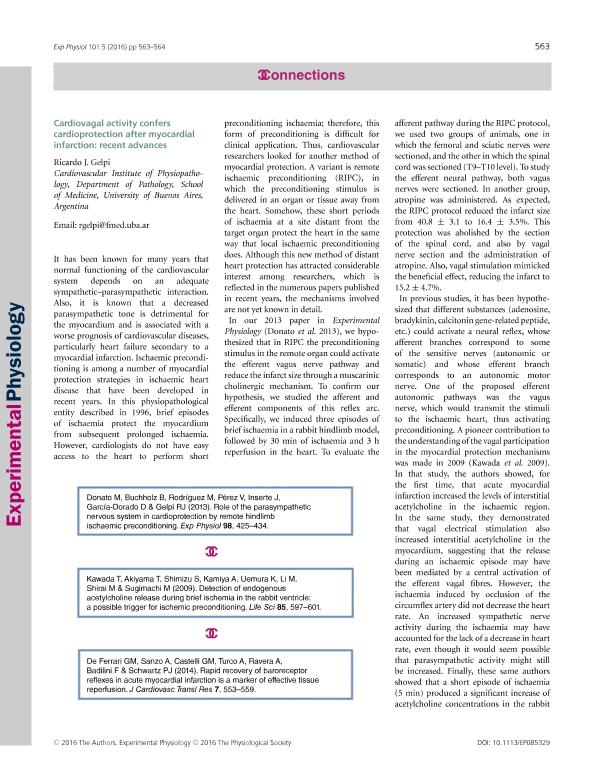Mostrar el registro sencillo del ítem
dc.contributor.author
Gelpi, Ricardo Jorge

dc.date.available
2018-03-15T18:51:32Z
dc.date.issued
2016-05
dc.identifier.citation
Gelpi, Ricardo Jorge; Cardiovagal activity confers cardioprotection after myocardial infarction: Recent advances; Wiley Blackwell Publishing, Inc; Experimental Physiology; 101; 5; 5-2016; 563-564
dc.identifier.issn
0958-0670
dc.identifier.uri
http://hdl.handle.net/11336/38973
dc.description.abstract
It has been known for many years that normal functioning of the cardiovascular system depends on an adequate sympathetic–parasympathetic interaction. Also, it is known that a decreased parasympathetic tone is detrimental for the myocardium and is associated with a worse prognosis of cardiovascular diseases, particularly heart failure secondary to a myocardial infarction. Ischaemic preconditioning is among a number of myocardial protection strategies in ischaemic heart disease that have been developed in recent years. In this physiopathological entity described in 1996, brief episodes of ischaemia protect the myocardium from subsequent prolonged ischaemia. However, cardiologists do not have easy access to the heart to perform short preconditioning ischaemia; therefore, this form of preconditioning is difficult for clinical application. Thus, cardiovascular researchers looked for another method of myocardial protection. A variant is remote ischaemic preconditioning (RIPC), in which the preconditioning stimulus is delivered in an organ or tissue away from the heart. Somehow, these short periods of ischaemia at a site distant from the target organ protect the heart in the same way that local ischaemic preconditioning does. Although this new method of distant heart protection has attracted considerable interest among researchers, which is reflected in the numerous papers published in recent years, the mechanisms involved are not yet known in detail.
dc.format
application/pdf
dc.language.iso
eng
dc.publisher
Wiley Blackwell Publishing, Inc

dc.rights
info:eu-repo/semantics/openAccess
dc.rights.uri
https://creativecommons.org/licenses/by-nc-sa/2.5/ar/
dc.subject
Sistema Autonomo
dc.subject
Infarto de Miocardio
dc.subject
Proteccion
dc.subject
Nervio Vago
dc.subject.classification
Inmunología

dc.subject.classification
Medicina Básica

dc.subject.classification
CIENCIAS MÉDICAS Y DE LA SALUD

dc.title
Cardiovagal activity confers cardioprotection after myocardial infarction: Recent advances
dc.type
info:eu-repo/semantics/article
dc.type
info:ar-repo/semantics/artículo
dc.type
info:eu-repo/semantics/publishedVersion
dc.date.updated
2018-03-15T14:09:07Z
dc.journal.volume
101
dc.journal.number
5
dc.journal.pagination
563-564
dc.journal.pais
Reino Unido

dc.journal.ciudad
Londres
dc.description.fil
Fil: Gelpi, Ricardo Jorge. Universidad de Buenos Aires. Facultad de Medicina. Instituto de Fisiopatología Cardiovascular; Argentina. Consejo Nacional de Investigaciones Científicas y Técnicas; Argentina
dc.journal.title
Experimental Physiology

dc.relation.alternativeid
info:eu-repo/semantics/altIdentifier/doi/http://dx.doi.org/10.1113/EP085329
dc.relation.alternativeid
info:eu-repo/semantics/altIdentifier/url/http://onlinelibrary.wiley.com/doi/10.1113/EP085329/abstract
Archivos asociados
